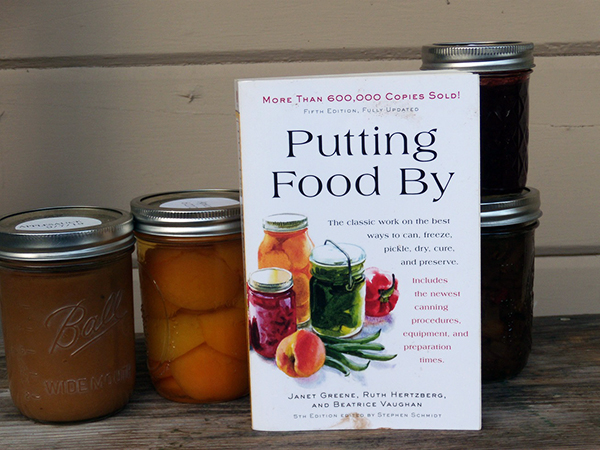Review by Margie Siegal
 It’s canning day, so I get up early in the morning to avoid the midday heat. I have cleaned the kitchen the night before. I get the produce I have picked and start processing it. Jars get washed in hot soapy water and then boiled. I double check to make sure I have enough lids – they are one time use only. I put a bookmark at the page in Putting Food By (Greene, Hertzberg and Vaughan, Plume Books, 5th ed, 2010) which gives instructions for processing the fruit or vegetable I am working with. Putting Food By is my canning Bible.
It’s canning day, so I get up early in the morning to avoid the midday heat. I have cleaned the kitchen the night before. I get the produce I have picked and start processing it. Jars get washed in hot soapy water and then boiled. I double check to make sure I have enough lids – they are one time use only. I put a bookmark at the page in Putting Food By (Greene, Hertzberg and Vaughan, Plume Books, 5th ed, 2010) which gives instructions for processing the fruit or vegetable I am working with. Putting Food By is my canning Bible.
Canning is a lot of work, but rewarding: it results in rows of jars with bright contents and a promise of a bit of summer to eat during winter storms. In these trying times, with many experiencing economic hardship, canning food you grow yourself or obtain inexpensively from other sources may be a real boost to the family budget. Canning jars and lids are cheap and the jars can be re-used indefinitely. Most of the other necessary items are either on hand or can be bought used.
The canning process was invented during the time of the Napoleonic Wars and developed during the 19th century. It quickly caught on in American farm country. Granges, agricultural bureaus and country extension agents soon became concerned that all the farmers that were taking up canning do it right, since safe canning depends on exact timing and temperatures. Soon, public agencies and land-grant colleges were putting out pamphlets explaining how to process those jars of food for long term safe keeping. The pamphlets piled up.
In the 1970’s, a new generation of back-to-the-landers were trying their hand at food preservation, and needed a guiding hand. Three experienced New England canners, Janet Greene, Ruth Hertzberg and Beatrice Vaughn, gathered the available information and added their practical knowledge and a folksy twist. The result was Putting Food By, an instant classic. Since 1973, it has gone through five editions (last one published in 2010). The cover boasts that more than 600,000 copies have been sold.
Putting Food By (often abbreviated as PFB) has clear, precise explanations of WHAT to do and clear, understandable explanations of WHY. The “why” is often left out of other manuals, which just tell you that there is only one way to do things and if you deviate one iota you and your loved ones will suffer a painful death. In addition to comprehensive canning information, the book has instructions on how to efficiently and safely freeze, dry and pickle your food. There are chapters on smoking meats and preserving seafood. There are a lot of recipes: most traditional Northern European but also salsa and an excellent chutney.
Readers should know that Putting Food By has been controversial. The “Healthy Canning” website [https://www.healthycanning.com/] complains that PFB contains information that is not USDA approved, for example, instructions for pressure canning with a pressure cooker, instead of a pressure canner. The overall problem seems to be that PFB gets information from commercial canners and that the editors of the Healthy Canning website can’t verify it. The Healthy Canning editors also worry that new canners will use PFB as a license to do Bad Things.
To show how PFB combines accurate information with down home flavor, here are the PFB instructions for:
APPLESAUCE (HOT PACK ONLY)
“Prepare by your favorite rule and according to how you’ll use it- chunky or strained smooth; sweetened or not; with spices (cinnamon, nutmeg, whatever) or plain. Because of complete precooking and being packed so hot, processing time is relatively short and is designed to ensure destruction of spoilers and a good seal.
Pare crisp apples, cut in quarters or eighths, and remove core parts; drop in anti-discoloration solution (Don’t throw away the peels and cores, save them to boil up for a beautiful juice for jelly) Put about 1 inch of water in a large enameled or stainless steel kettle, fill with well-rinsed apple pieces to within 2 inches of the top. Bring to a boil, stirring now and then to prevent sticking, and cook until apples are tender. Leave as is for chunky sauce, or put it through a sieve or food mill or blend in a food processor for smoothness. Sweeten to taste if you like; bring it briefly to boiling to dissolve any sweetening. Pack very hot in jars. Fill clean, hot jars with piping hot sauce, leaving ½ inch of headroom; adjust lids. Process in a Boiling-Water Bath (212 F/100 C) 20 minutes for either pints or quarts. Remove jars; complete seals if using bailed jars.”
All terms of art (headroom, Boiling-Water bath, anti-discoloration) are explained in depth in other parts of the book and are easy to find in the comprehensive index. Note that the instructions assume that you have a favorite recipe for applesauce and want to use it, so no exact instructions are given. In cases where exact measurements are essential (and PFB always explains why) exact measures are given.
I have been using Putting Food By for years and have become a successful canner as a result of using the information in this book. I feel that Putting Food By is absolutely essential if you are planning to homestead in your back yard.
